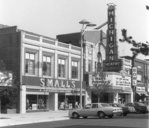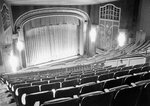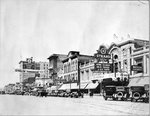


A century ago, on April 21, 1921, a splendid new theater opened in downtown Lansing, at 215 N. Washington Avenue.
Telegrams from around the world, had to be carried in by the bushel, including one from Charlie Chaplin, congratulating owner W. S. Butterfield and his staff.
The Strand Theatre survived the era of vaudeville to become a classic, big-city downtown movie palace, under the rubric of the Michigan Theatre, until its partial demolition in 1982.
Only the ornate terra cotta façade survives — a creamy baroque throwback tucked between empty storefronts, bail bondsmen and cigar stores — along with an arcade of offices inside the building.
Although the Stand/Michigan Theatre spent most of its life as a movie house, a long line of American entertainers, from Al Jolson to Dave Brubeck, appeared there.
“I was the last person on that stage,” Chicago architect Thom Greene said. “I read a short poem, long ago, when the building was half torn down and snow was coming through the ceiling. It was quite a night for me.”
Two original seats from the Michigan Theatre, and a piece of swirly red Art Deco carpet, are still sitting in his garage.
Greene was part of a plucky but unsuccessful effort to save the theater, Da Capo, that included a fund-raising concert by jazz pianist Dave Brubeck. Greene wrote his fifth-year thesis, at Lawrence Technological University, on the Strand/Michigan Theatre.
“The Lansing Strand Theatre was not built for today only,” read the opening night program, “but constructed in the hope that it might be a monument for years to come.”
The Strand Theatre was built for Walter Scott Butterfield, who owned 19 theaters in Michigan and several more out of the state. Butterfield hired one of the leading architects of the day, John Eberson, who specialized in grand theater designs.
Butterfield’s granddaughter was the model for a beautiful terra cotta relief by Kristian Schneider, a friend of iconic Chicago architect Louis Sullivan. Her face still looks down on passersby along Washington Avenue. The identity of the terra-cotta lady whose bosom morphs into a descending column of plaster is unknown.
A golden age of live entertainment was at its height in 1921. The Strand started as a 1,750-seat vaudeville theatre and hosted big attractions like crooner Bing Crosby, singer and dancer Ruby Keeler, folksy comedian-philosopher Will Rogers, opera and spirituals singer Marian Anderson, talkie pioneer Al Jolson and magician Harry Houdini. There were jugglers, dancers, comedians and animal acts. (Animals had their own dedicated “dressing” room.)
Ground was broken March 16, 1920. The cost was estimated at $500,000, and local labor and materials were used as much as possible. Young Brothers and Daley, a Lansing firm that is still in business, provided 3,000 barrels of cement, 30,000 feet of gypsum block and 20 tons of stucco. The R.C. Smith Co. of Battle Creek provided 194 tons of structural steel. The 64-foot-long steel truss that supports the balcony — still in place today — weighed 15 tons alone. A state of the art ventilation system changed the air in the cavernous auditorium every six minutes.
The theater’s grand scale and lavish décor were a big part of the draw. Opening night reviews in the local press concentrate completely on the theater and don’t even mention the opening night acts, aside from speeches by civic leaders like Lansing Mayor Benjamin Kyes.
To experience an “atmospheric picture palace” similar to the Strand today, you’d have to go to the Kalamazoo State Theatre, also designed by John Eberson, one of the few in the nation that remain intact.
The unique thing about the Strand was its arcade of 14 shops, an early urban mall that ushered the visitor toward the theater beyond.
Betty Kopit, an MSU Theatre Department student, lovingly described the theater’s visual delights in a thesis on the theater’s history in 1976. The arcade had amber skylights, a marble staircase, copper framed windows and a second-floor convention hall-ballroom with a parquet floor. At the far end, patrons passed through four beveled glass doors into the theater lobby, a dreamy layer cake of Roman columns, ornate plaster work and twisting staircases. At the top was a dome and rotunda with a fantastic bronze and glass lamp in the form of a palm tree and a multi-colored parrot, imported from Italy.
Beginning in 1928, an organ dramatically raised out of the pit, to the great excitement of patrons, as a prelude to the entertainment (by then, mostly movies).
The aging frou-frou décor of 1921 got a sharp Art Deco remake in 1941. A classic neon sign rocketed boldly from the façade, proclaiming the theater’s name change to the Michigan. Old theatrical names like the Strand, Bijou and Jewel were going out of fashion. The interior was streamlined and side boxes were taken out of the auditorium.
By the 1960s and 1970s, suburban mall theaters and TV were turning America’s downtown movie palaces into haunted, sticky-floored mausoleums. Butterfield’s burgeoning theater empire had moved on, to malls and campuses like MSU, where Butterfield opened the twin Campus Theater in 1980.
By the 1970s, the basement bowling alley and other spaces at the Strand were long vacant, as was much of the upper arcade. Other than Monday nights, when admission was discounted to $2.50, “the partially filled seats on the main floor make the theater seem even more vast than it is,” Kopit wrote.
Greene and the Da Capo group thought the arcade had the potential to make the whole theater viable, but no developer came forward to save the auditorium, as the Hinman Co. did for the Kalamazoo State Theatre.
Greene believes that the Strand’s commercial arcade, intended as a hedge against the roller-coaster ups and downs of showbiz in 1921, saved the whole building from coming down. The arcade was converted to the Atrium Office Plaza in 1982 and is now home to the Dickinson Wright law firm, among other tenants.
The ghost theater is still visible, if you look for it, in the harsh, sunlit parking lot behind the facade. Motorists and pedestrians on Grand Avenue can still see the distinct outlines of each tier of seats.
“They just tarred over the balcony seating,” Greene said. “It was quite an abomination.”
Greene soldiered on as an architect in Lansing, later chairing the Lansing Downtown Development Corp. and serving on the Ingham County Historical Commission, but the loss of the Strand was a great disappointment to him and to his fellow Da Capo fighters.
“That is why I ended up relocating my firm to Chicago. Lansing just didn’t get it. They didn’t have the sensitivity. The City Council was just too backward. I had to go to a more progressive city.”
1 comment on this item Please log in to comment by clicking here
Support City Pulse - Donate Today!
Coltron3108
Very cool article as someone who works in this building every day. Dickinson Wright has moved out for the record. Only their sign remains on the front
Thursday, April 22, 2021 Report this